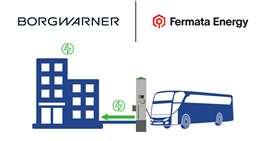Fermata Energy integrates with BorgWarner chargers
07 February 2024
Integration with BorgWarner bidirectional chargers to enhance charging capabilities for EV fleets
 Fermata Energy integration with BorgWarner bidirectional chargers enhances V2X charging capabilities for EV fleets (Illustration: Business Wire)
Fermata Energy integration with BorgWarner bidirectional chargers enhances V2X charging capabilities for EV fleets (Illustration: Business Wire)
Fermata Energy, a developer of intelligent bidirectional technology solutions, announced the integration of its Vehicle-to-Everything (V2X) services platform with bidirectional EV chargers manufactured by BorgWarner Inc.
Together, Fermata Energy said the companies are accelerating efforts to integrate bidirectional charging capabilities with a variety of automotive OEMs. It said the move promotes wider accessibility while lowering the electric vehicle Total Cost of Ownership (TCO) through intelligent bidirectional charging technology.
The integration of Fermata Energy’s software with BorgWarner’s hardware, includes both of their UL certified 60 kW and 125 kW chargers.
The announcement is a major step towards accelerating the availability of intelligent bidirectional technology for a much broader range of medium- and heavy-duty transportation use cases, said Fermata Energy. It also paves the way for broad use in the North American market by enabling Fermata Energy’s innovative platform to optimize V2X bidirectional charging commands with a Combined Charging System (CCS) communication protocol.
Founed in 2010, Fermata Energy said it is actively working with various automotive OEMs to embed bidirectional charging capabilities, showcasing its dedication to innovation in the bidirectional charging market. For example, in November, Fermata Energy announced a strategic research project with Toyota Motor North America and San Diego Gas & Electric Company. In 2022, Nissan approved Fermata Energy’s FE-15 bidirectional charger as the first bidirectional charger for use with the Nissan Leaf in the U.S. without impacting the vehicle’s battery warranty.
Bi-directional charging technology means not only charging vehicles, but also sending energy stored in the vehicle battery back to a building or the grid. For example, Nissan Leaf owners can use the Fermata Energy FE-15 bi-directional charger to save money with their local electric utility as well as reduce the total cost of ownership of the vehicle.
Fermata Energy said its Demand Charge Management application, along with the FE-15 charger, continuously monitors a building’s electrical loads, and may draw on the Leaf’s energy to provide power to the building during more expensive high-demand periods. The company said the technology is ideal for companies with fleet vehicles.
“As two early market leaders in the V2X bidirectional charging space, we’re thrilled to partner with BorgWarner,” said Tony Posawatz, CEO of Fermata Energy, Charlottesville, Va. “The integration of our technologies not only broadens economic EV accessibility, but it reinforces our commitment to accelerate a renewable energy ecosystem.”
“BorgWarner is once again proud to partner with Fermata Energy, supplying our bidirectional EV chargers to this exciting project,” said Isabelle McKenzie, Vice President of BorgWarner Inc. and President and GM, Morse Systems. “Developing clean energy innovations like V2X technology is key to building a sustainable and climate-resilient future.”
Fermata Energy said the announcement grants fleet operators access to diverse value streams across numerous utility service territories to accelerate the adoption of bidirectional technology and transition to renewable energy.
In December 2023, Vancouver, B.C., Canada-based tour company Coast to Coast Experiences (CTCE) introduced what it said is Canada’s first Vehicle-to-Grid (V2G) pilot project for medium- and heavy-duty vehicles. Working with BC Hydro, Lion Electric, BorgWarner, PowerTech Labs and Fermata Energy, CTCE’s V2G mobile power infrastructure enables stored energy from CTCE’s electric bus fleet to support power grids, such as BC Hydro peaking and demand response initiatives.
In collaboration with the pilot program partners, the bidirectional charging platform from Fermata Energy enables the parked electric buses to be utilized as mobile batteries with stored energy discharged to mitigate peak energy demand, send power back to the grid, lower the vehicles’ total cost of ownership and create value for electric fleet operators.
Fermata said that CTCE’s electric buses, which stand idle many hours each day, can become valuable mobile power plants, allowing utilities, such as BC Hydro, to leverage power from the bidirectionally-enabled electric vehicle during peak periods to offset the grid. This will be especially crucial during inclement weather and natural disasters when extreme pressure on the grid creates the potential for outages.
STAY CONNECTED




Receive the information you need when you need it through our world-leading magazines, newsletters and daily briefings.
POWER SOURCING GUIDE
The trusted reference and buyer’s guide for 83 years
The original “desktop search engine,” guiding nearly 10,000 users in more than 90 countries it is the primary reference for specifications and details on all the components that go into engine systems.
Visit Now
CONNECT WITH THE TEAM










